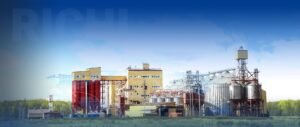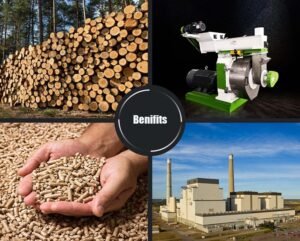
Today, aquatic floating feed machine technology is very popular in the production of aquafeeds, as it can be used to produce a variety of feeds, whether floating or sinking, depending on the needs of each species. In addition, the extruded feed made by aquatic floating feed machine has less adulteration and high efficiency, helping to improve digestibility.
During the aquatic floating feed machine extrusion process, mechanisms such as temperature, humidity, pressure will increase starch gelatinization, decompose and soften the cell wall and release some easily digestible substances, thus promoting the digestion and absorption of farmed animals.
Through aquatic floating feed machine extrusion technology, it is possible to inhibit certain protease inhibitors (such as antitrypsin), destroy pathogens in raw materials or change protein properties to further improve the contact with enzymes in fish and shrimp, helping to digest food more easily.
Extruded feed made by aquatic floating feed machine can control the content of compounds and help better detoxification. At the same time, the longer stabilization time in the water (12-36 hours) helps farmers to observe and control the feeding schedule.
Although extruded feed made by floating fish feed making machine has obvious advantages over pelleted feed, the initial investment cost of extruded feed production is higher, resulting in higher feed costs.
But for high-end fish farming, more and more people are paying attention to the market prospect of high-end fish feed.
1. Main features of aquatic floating feed machine
- Feeding, rotary cutting, and main drive all adopt frequency conversion speed regulation system, which has strong power, stable operation, energy saving, high aquatic production efficiency, durable equipment, low failure rate, and convenient operation and maintenance.
- The screw of floating feed machine is made of alloy material by special process, the service life is 3-4 times longer than that of domestic similar machines, and the cost of producing feed is low; the segmented combined screw is suitable for a wide range of raw materials and more diverse products.
- Automatic lubrication system of the floating feed machine reduces mechanical energy consumption and prolongs service life.
- The feeding system adopts spiral forced feeding, and the feeding is uniform and wide. It can be equipped with an automatic feeding system. The feeder is a screw conveying variable frequency speed control to adjust the feeding amount to control the puffing output (quantitative feeding, and can effectively prevent the material from arching).
- Linear bearing tool adjustment system, adjust the tool accurately and quickly.
- The twin-screw of floating feed machine has self-cleaning function, and the use of equipment is more reasonable and convenient.
- Update the configuration of various equipment technology and equipment to make the output of the twin-screw floating feed machine larger.
- Different screws and length-diameter ratios can meet different production processes. (Related post: floating fish feed making machine)
- Visual automatic temperature control system to make temperature control more intuitive and parameters more accurate.
- The overall floating feed machine configuration The operation of the fish feed pellet extruder is more intuitive and the maintenance is more convenient.
- Dry puffing process adopts self-heating method without steam system, which is more in line with the actual needs of users.
- No adhesive is needed to process the floating feed, and it can maintain stability in water for more than 12 hours.
- Small and medium equipment is especially suitable for scientific research institutions, special breeding farms or medium and small feed factories. There are also specially customized experimental twin-screw floating feed machines available for scientific research units.

2. The difference between pellet feed and extruded feed
With the development of the floating fish feed processing industry, two widely used technologies currently used to produce aquafeed are pelleting and extrusion by floating feed machine. Compared to natural baits, such feeds have higher nutritional content and stability, less moisture, easier storage, fewer pathogens, and longer storage times.
Pelletizing by floating feed machine is a technique of compressing small pellets of raw material into larger pellets, during which humidity, temperature and pressure can greatly affect the quality of the feed. (Related post:twin screw extruder for sale)
- One of the main advantages of pelleted feed is lower production costs. However, it has some drawbacks.
- One of the biggest disadvantages of pelleted feed is that it sinks faster and dissolves quickly in water (according to statistics, about 10-15% of feed is wasted), which means higher feed costs, lower farming profits, and easier cause water pollution.
3. Choose pellet feed or extruded feed?
Farmers, choose pellet feed or extruded feed?
When choosing feed, farmers should consider the characteristics of different aquatic species and feeding habits. Because the habit of shrimps and crabs is to find food at the bottom, and then eat the food slowly, so the food should not be too hard and not easily soluble in water.
Therefore, extruded sediment by floating feed machine is the best choice because it is soft and difficult to dissolve in water, and it is convenient for shrimp and crab to eat, reducing feed waste and reducing water pollution.
Especially in intensive shrimp farming, extruded feed should be dominant, because it is easier for shrimp to digest protein from extruded feed, which minimizes feed waste and promotes better protein absorption.
At the same time, we can also increase the absorption rate of the feed by adding beneficial microorganisms or stimulating digestive products to the feed.
However, from a long-term point of view, the use of extruded feed, which is made by floating feed machine will increase the cost, and if the fish use extruded feed in the mature period, it may lead to fish fat, large belly, poor stress ability, not suitable for long-distance transportation, etc. , resulting in a low price at the time of sale.
Therefore, in the process of aquaculture, when many farmers use feed, they often use a combination of pellet feed and extruded feed, which not only regulates water quality, reduces feed residues, but also improves productivity and economic benefits.
At the same time, the aquaculture industry is promoting the further development of the two feeds due to their respective advantages.
4. Installation of floating feed machine
(1) Installation of floating feed machine pipeline rack
The choice of the installation position of the pipeline rack depends on the site location, but it should not be too far from the main engine. Far from the main engine will cause waste of materials during pipeline connection on the one hand, and cause the hysteresis of the control system on the other hand. (Related post:animal feed mill plant)
If the installation location on site allows, the best position of the pipeline rack is to be directly behind the main engine and conditioner, parallel to the main engine, and about 1 meter away from the main engine (there is a certain maintenance space), while ensuring that the pipeline rack is adjusted upwards. The position of the steam line interface of the conditioner is on the side of the conditioner.
In order to facilitate the cleaning of the ground and the outflow of waste water in the future, the pipe rack should be raised by about 10 cm during installation. In the installation of each valve in the pipeline, the position of the valve wheel should meet the needs of convenient operation for floating feed machine.
(2) Installation of floating feed machine control box
In order to facilitate the operation, the installation position of the on-site control box should be selected near the bypass, and a certain space should be reserved between the bypass and the control box to temporarily place the wastes flowing from the bypass.
The distance between the frequency converter of the cutting motor and the rotary positioner of the on-site cutter should not be too far. It is controlled by voltage. If the distance is too far, it will cause voltage fluctuations and affect the cutting effect.
The circulating temperature display instrument on the on-site control box is to display the temperature of each end of the puffing cavity in real time, and the displayed temperature sequence has certain requirements. Section 2 Expansion cavity…until the material discharge expansion cavity, this sequence needs to be paid attention to when wiring the electric control.
In addition, there are 4 nozzles on the water inlet pipeline of the dual-shaft differential conditioner of floating feed machine. They control the opening of each nozzle through the electromagnetic cut-off valve.
The floating feed machine conditioner inlet nozzle switches 1 to 4 on the control box correspond to the conditioners The 1st nozzle to the 4th nozzle from the feed end.







